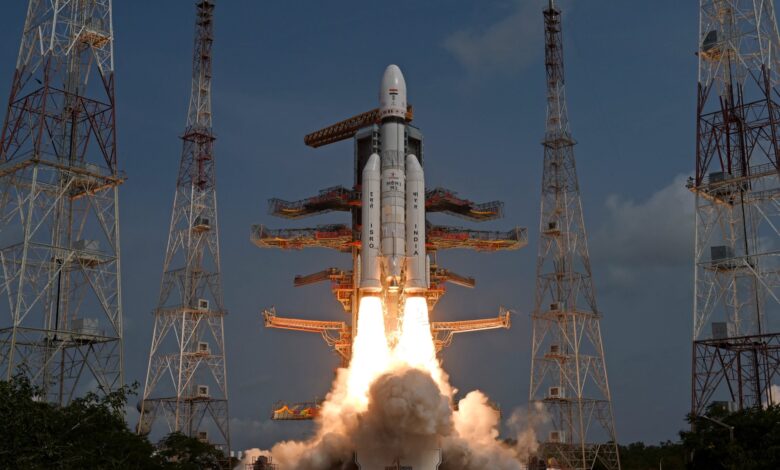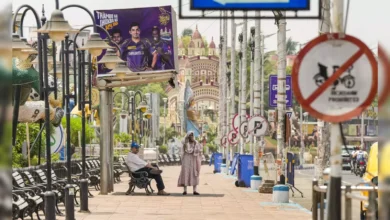
Today at 2.35 pm, India’s Chandrayaan-3 will take off from Sriharikota in Andhra Pradesh, carrying the aspirations of the entire nation. If the mission is successful, India will become the fourth country to achieve a lunar landing.
Unlike its predecessor, Chandrayaan-2, which consisted of the Orbiter, Lander (Vikram), and Rover (Pragyan), the Chandrayaan-3 mission incorporates an indigenous propulsion module, lander module, and rover.
One notable addition to Chandrayaan-3 is the inclusion of a specialized instrument called the Spectro-polarimetry of HAbitable Planet Earth (SHAPE), which was absent in the previous mission. The SHAPE instrument has been integrated into the propulsion module of Chandrayaan-3.
Back in 2019, the chairman of the space agency, K Sivan, estimated the cost of the Chandrayaan-2 mission to be approximately Rs 1,000 crore. On the other hand, the Chandrayaan-3 mission has been budgeted at around 615 crore.
The moon lander, Vikram, will be mounted on a powerful GSLV Mark 3 heavy lift launch vehicle, commonly referred to as the Bahubali rocket. The GSLV has been renamed Launch Vehicle Mark 3 (LM-3) and stands at a height of 43.5 meters, which is half the height of Delhi’s Qutb Minar. The anticipated duration of the journey is over 40 days, with the spacecraft expected to make its lunar touchdown on August 23.
For the first time, India’s mooncraft will attempt to land in the South Pole of the moon, a region where water molecules have been discovered. This significant finding, made during India’s inaugural moon mission in 2008, garnered worldwide attention.
Vikram, the lander, has been designed to achieve a secure and gentle touchdown. Subsequently, the rover, Pragyan, will be deployed to explore the lunar surface for a duration equivalent to a lunar day, which is approximately 14 earth days. The rover will perform scientific experiments, including the analysis of lunar soil, traversing the moon’s terrain, and logging moonquakes.
Nearly four years after the partial failure of Chandrayaan-2, which was launched into space on July 22, 2019, Chandrayaan-3’s launch has finally arrived. Unfortunately, during the early hours of September 7, the lander Vikram and the rover Pragyaan from Chandrayaan-2 experienced a crash landing on the Moon’s surface.
Problems in the previous mission:
During the previous mission, the Indian Space Research Organisation (ISRO) faced a communication loss with Vikram when it was a mere 335 meters (0.335 km) away from the Moon’s surface. According to the initial data from ISRO’s Telemetry Tracking and Command Centre, the failure occurred during the “Fine braking phase” in the last leg of Vikram’s journey, specifically between an altitude of 5 km and 400 m, which was activated when the lander was 5 km away from its intended lunar landing site.
The expansive screens at the center displayed a noticeable divergence in the green line, representing the lander, starting when its altitude surpassed 2 km. The deviation persisted and eventually halted at a position visibly below 1 km altitude, approximately around or below 500m.
During the prrevious mission, the module maintained a vertical velocity of 59 meters per second (equivalent to 212 km/hr) and a horizontal velocity of 48.1 meters per second (equivalent to 173 km/hr). The lander was approximately 1.09 km away from its designated landing location on the Moon at that point.
As per the original plan, Vikram was expected to significantly reduce its velocity by the time it reached a distance of 400m from the lunar surface. It should have been in a hovering state above the intended landing site, preparing for a gentle vertical descent at a speed comparable to walking pace. However, due to its high velocity, the lander crashed onto the Moon’s surface.
During a media briefing, Isro Chairman S Somanath highlighted three critical mistakes that resulted in the hard landing of Vikram. Somanath explained that the first issue arose from the engines used for velocity reduction, which unexpectedly produced higher thrust than anticipated. This higher thrust led to a cumulative accumulation of errors, compromising the lander’s stability during the “camera coasting phase” for the soft landing.
The second problem occurred as the accumulated errors exceeded expectations, causing the spacecraft to execute rapid turns beyond the software’s anticipated limits. Somanath stated that the software did not account for such high turning rates.
The third problem emerged when the lander, despite its proximity to the lunar surface, experienced an increase in velocity due to the landing site being a relatively small area measuring 500 m x 500 m.
“In summary, the limited capacity to manage parameter dispersion was the fundamental issue in Chandrayaan-2,” he stated.
What improvements have been made?
According to ISRO Chairman S Somanath, significant improvements have been made to the lander. One of the key enhancements focused on strengthening the lander legs to withstand higher velocities compared to the previous Chandrayaan-2 mission. The velocity tolerance has been increased from 2m/second to 3m/second, ensuring that even at 3m/second, the lander will not crash or damage its legs.
Additionally, extra solar panels have been incorporated into the lander. This addition aims to ensure a continuous power supply regardless of the landing position or orientation, as mentioned by Somanath in an interview.
To ensure robustness, the spacecraft underwent various tests. Helicopter flights were used to subject the spacecraft to vibrations over different terrains, while cranes were employed to simulate landing processes. New test beds were developed for simulations, specifically to analyze failure scenarios, which were not available in the previous mission.
Notably, Chandrayaan-3 carries a larger quantity of fuel compared to Chandrayaan-2. This enhanced fuel capacity improves the spacecraft’s range, dispersion handling capabilities, and the ability to reach alternate landing sites if required.
Additionally, a new sensor called the laser Doppler velocity meter, which examines the lunar terrain, has been included. This sensor enables the spacecraft to obtain three velocity vector components, thereby enhancing redundancy in measurements when combined with other instruments.
The lander is equipped with a Laser Retroreflector Array (LRA), as reported by Business Today. Furthermore, Chandrayaan-3 features two lander hazard detection and avoidance cameras, an improvement over Chandrayaan-2’s single camera. These cameras are also reported to be of superior quality compared to their predecessor, as mentioned by ISRO.
In contrast to a success-based design approach in Chandrayaan-2, Somanath stated that the space agency chose a failure-based design approach for Chandrayaan-3.



